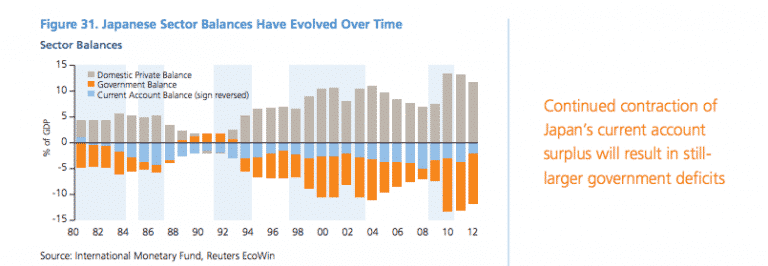Chart of the Day: Japan’s Sectoral Balances
Let’s talk about deficits for a second. The term deficit has some pretty serious negative connotations. So when we use that word, usually the implication is that the deficit is bad. Here’s the thing though; as I have written here a number of times, any economic agent’s net deficit is offset by another economic agent’s net surplus. So in the context of trade, current account or budget deficits, these all net to zero. This is accounting 101.
Last year I was complaining about people not getting this. But we have shown this to you for the US (more than once), for Italy, for Ireland and France, and for the Eurozone. So by now, I imagine you understand the concept pretty well.
Here’s Japan’s version of the same chart:
The purpose is not just to present a backward-looking ‘balance sheet’ but always to understand what we should expect going forward.
Every time you see one of these sectoral balance charts, you should be asking yourself what would happen if one sector’s balance shifts dramatically. For example, we saw that a housing crash caused households to retrench leading to the dramatic shift toward net surpluses of household balances in places like Spain, the US, the UK and Ireland. This is what deleveraging means. And when that happens, it shift s the other balances i.e. combined external capital and government balances in equal measure toward deficits.
In Japan, the shift may be toward greater government deficits since that’s what the Japanese Prime Minister has said. To me, this is more important than the threats about the inflation target because that’s what will increase GDP and move currency exchange rates. Using the sectoral balances approach to understand the impact of this policy is important.
In the US, I believe the desired shift in the government balance will be in the opposite direction, just as it has been in Europe and in Britain. Will it work though? A shift in the government sector has to mean a net shift in the private or external capital sectors of the same amount. The US household sector IS still indebted despite the fall in debt service costs. I can’t see the shift happening there. Likely, we would have to see a fall in corporate profits (net saving), a fall in current account deficits, or the policy will fail. Likely, we will see all three: declining profitability, lower trade deficits and missed deficit targets – as we have seen in Europe’s periphery.
Japan is another story. I’ll have more to say on Japan later.
Source: Pragmatic Capitalism

Comments are closed.